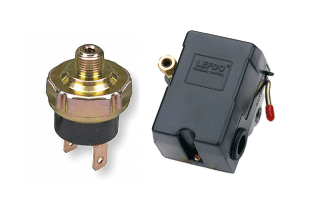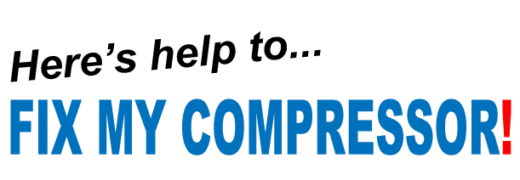Every air compressor with a tank has a pressure switch. Most really small air compressors with no tank have a pressure switch. If you aren’t sure what a compressor switch is or how a compressor pressure switch works, this is the page for you.
There are many different types of pressure switches in compressors, but really, the concept for how all of them work is the same.
For smaller compressors with the pressure switch installed right into the tank, there will be two wires running from the supply cord. One of these is the “hot” or power line, the other is the “return”. The “hot” line runs to the switch and then runs from the switch to the compressor motor.
The wire to the motor from the switch may first be connected to a thermal switch in the motor. That thermal switch or thermal cut out is there to help protect the motor from overheating. The wire will continue on from that thermal switch to the motor terminal.
The other type of pressure switch – and what they look like will vary depending on the make and source – is an external to-the-tank type. This type will have a nipple from the tank into the switch, most typically into the base of the switch. This allows air pressure in the tank to reach the pressure switch.

The external pressure switch typically often has 3 wires from the power cord, and two wires running from it to the motor circuit. On the supply side, the side from the plug, one wire is the “hot” or power wire (often black), another is the return (often white) and another is the ground or earth wire (often green).
Whether an in tank or on tank pressure switch, both do the same job.
Tank or Line Pressure Affects the Switch
The force that is exerted on the switch by the air pressure in the tank or air line varies depending on the pressure. When the tank pressure drops below the setting of a particular pressure switch the switch “trips”. When the tank pressure reaches the normal “stop” or full setting of a particular switch, the switch “trips” again.
The “tripping” of the switch will either allow power to flow to the motor circuit from the supply line, and the compressor motor starts, or when the rising tank or line pressure on a particular switch reaches the high-pressure setting for that switch, the switch “trips” again, this time cutting the power flow to the motor and the compressor stops running.
If you have any questions about the information on this page please add a comment below.
